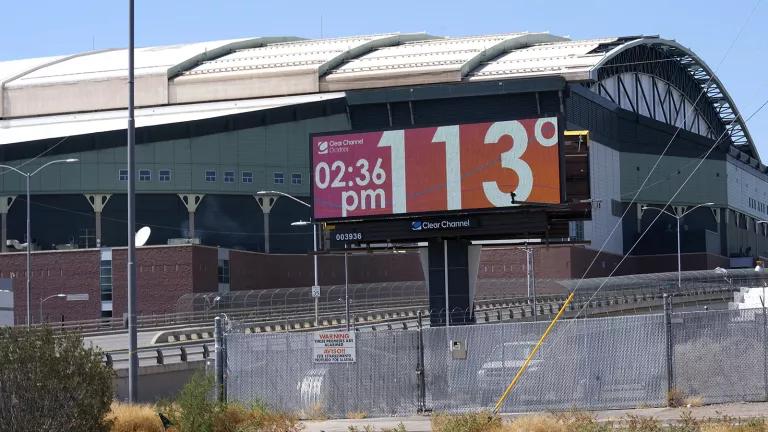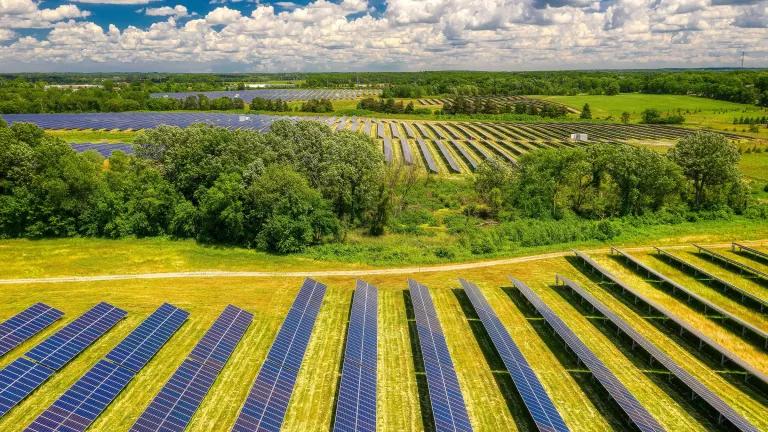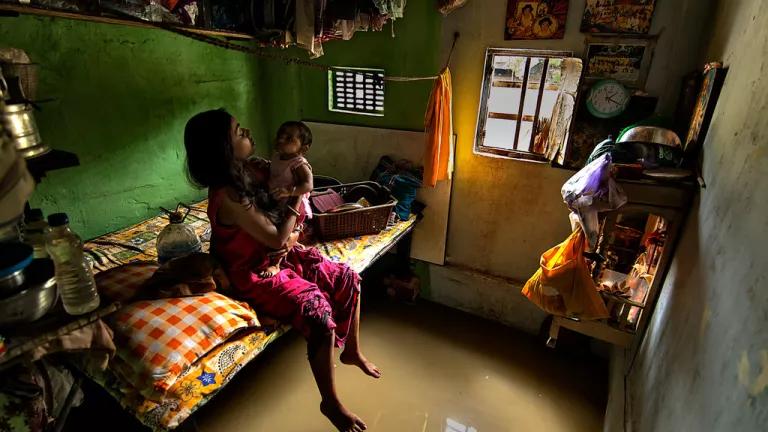Urban Greening & Cool Roofs Help Cities Address Extreme Heat
As climate change fuels soaring temperatures worldwide, low-cost adaptation strategies can help cities to keep cool.

Roadside trees in Delhi, India (Source: Wikimedia Commons).
Co-authored by Benjamin Steiger, Caroline Hoffman, Kathleen Chen (Recent MPH Graduates from Columbia University Mailman School of Public Health), Sophie Kimball (MPH/MBA student at Columbia University Mailman School of Public Health and Columbia Business School), and Prima Madan (cooling and efficiency expert working as a consultant with NRDC).
As temperatures soared to record highs in the US Pacific Northwest recently, the question of how to cope with a world that is hot and getting hotter grows ever more pressing. Extreme heat events are of particular concern in urban areas because of the density of buildings and roads, which absorb solar radiation and re-emit heat through the urban heat island (UHI) effect. These heat islands can experience daytime temperatures up to 4˚C warmer than rural areas and people living in such areas can suffer an increased risk of heat-related morbidity and mortality during extreme heat events, particularly for vulnerable populations.
Urgent Need for Low-Cost Climate Adaptation
Local solutions are urgently needed to address soaring temperatures that endanger people. Adaptive land cover techniques can function as low-cost measures that help communities to address numerous linked climate and health hazards. Two well-documented, low-cost strategies are urban greening, which boosts the quantity and quality of green spaces in cities, and cool roofs, which enhance the ability of rooftops to reflect incoming solar radiation instead of trapping heat.
While these adaptive landcover strategies have been implemented around the world for years, they are a topic of increasing scientific study because of their benefits for environmental conditions (including localized temperatures and air quality), human health (including potential reductions in heat-related illness), and reduced energy demand for cooling in buildings. Over the past six months, our research team undertook an extensive literature review to examine the environmental, health, and economic benefits of adaptive landcover interventions, primarily focusing on India, a country highly vulnerable to climate change. We recently presented highlights from our findings at a session during the 17th International Conference on Urban Health.
Dampening the Urban Heat Island
Urban greening interventions can help to combat the harmful health effects of the urban heat island effect on people. Urban green space reduces ambient air temperatures at the micro-scale via shade, and can also alter the thermal energy balance of the environment and cool local surroundings. Researchers in Bangalore, India, found that cooling can attenuate heat up to 347 m from the boundary of a green space. In certain contexts, urban greening can also aid in the deposition and dispersion of air pollutants, mitigating some of the health risks exacerbated in urban heat islands.
Overall, both modeling and experimental studies demonstrate the potential for cool roofs (including roofs with solar reflective coatings and green roofs) to reduce outdoor and indoor air temperatures. Cool roofs modify the characteristics of a roof to provide a net cooling benefit by increasing solar reflectance and thermal emittance on a roof (coated with a cooling paint, membrane or solar reflective tiles) or through evapotranspiration on a vegetation-covered green roof. For example, an experimental 2016 study in Nagpur, India showed that school rooms with white cool roof paint applied to their roofs were an average of 1.5-2.1 °C cooler and maximum of 3.3-4.3 °C cooler over a ten week observation period than roofs with darker gray paint. Additionally, a 2019 modeling study estimated that increasing the total green roof space across Mumbai, India to achieve 50% green roof coverage was associated with a 2-2.2 °C reduction.
Addressing Health Hazards from Rising Temperatures
Extreme heat exposure can impair the body’s ability to thermoregulate, worsening risks of heatstroke and the exacerbation of underlying respiratory and cardiovascular disease and other chronic illnesses. By lowering ambient and indoor air temperatures, urban greening and cool roofs can dampen extreme heat exposure and reduce the risk of heat-related mortality. Studies have shown that increased access to and usage of green space is positively associated with individual health benefits, including improvements in mental health and reductions in chronic disease prevalence. Additionally, exposure to greater tree canopy coverage has been linked with lower incidence of self-reported fair to poor general health and lower psychological distress. Populations most at-risk of heat-related morbidity, including lower socioeconomic groups, children, and the elderly, may attain greater improvement in general health from increased urban green space exposure compared to other populations, providing implications for achieving health equity.
Reducing Energy Demand
By providing shade for adjacent buildings and by reducing a building’s absorbed solar radiation, street trees and cool roofs, respectively, can reduce demand for energy to cool buildings. This pathway results in substantial energy-related cost savings and potentially reduced power plant pollution emissions. For example, the Chicago Urban Forest Climate Project showed that a 10% increase in street tree cover may lower annual energy costs by 5-10%. Whitening existing black roof tops may reduce cooling energy usage by 14-26%, while a study of 760 m2 cool roofs in India indicated that energy savings offset the total implementation and maintenance costs in under 3.3 years in hot to temperate climates.
Expanding Implementation
Given the multiple benefits of adaptive landcover in the face of growing climate threats, many cities are expanding efforts on cool roof and urban greening programs. In response to growing health risks from rising temperatures including the deadly 2010 heat wave that triggered an excess of more than 1,300 deaths, Ahmedabad, India, launched South Asia’s first Heat Action Plan. That plan includes provisions to implement cool roofs on hundreds of buildings in low-income communities.
In the U.S., the OneNYC plan to address the climate crisis in New York City has committed to adding more street trees in the most heat-vulnerable areas, while the NYC CoolRoofs program provides cool roof installations at no cost for a range of building types, including low-income housing and schools. Given the present and increasing health threat posed by extreme heat and the strength of the available evidence, it is imperative that similar investments in urban greening and cool roofs be implemented in cities across the world.
Climate change is not some distant threat, it is here and now, and it is getting worse every day that we continue to rely on polluting fossil fuels instead of cleaner, healthier, renewable energy sources like solar and wind. This summer’s searing heat episodes are a vivid example of the significant and growing risks posed by the climate crisis for our health. In the face of rising temperatures, investments and careful planning to expand adaptive landcover can help people cope with the heat and help cities to protect their most vulnerable residents.



